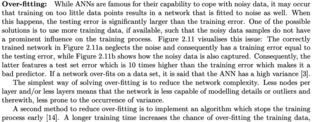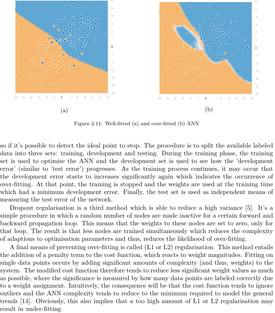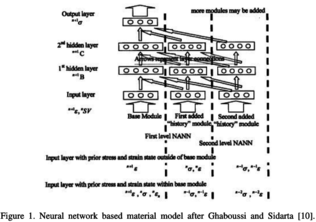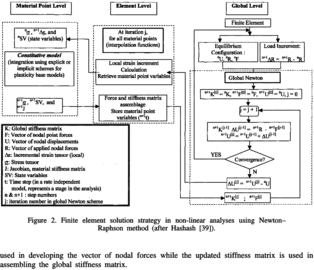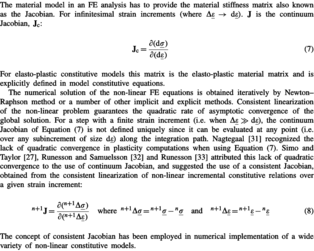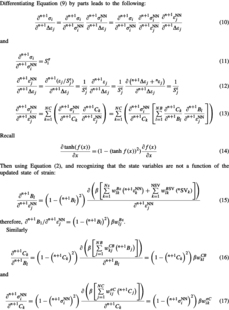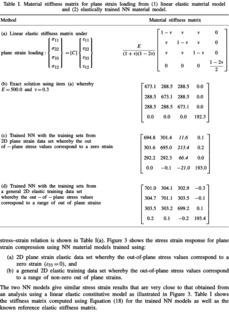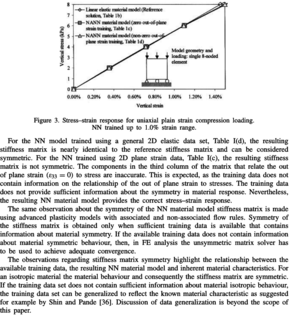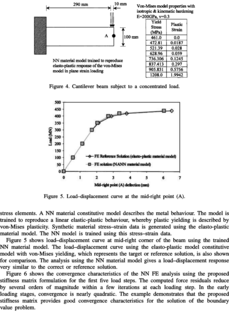Edited, memorised or added to reading queue
on 10-Mar-2021 (Wed)
Do you want BuboFlash to help you learning these things? Click here to log in or create user.
Flashcard 6269928082700
| status | not learned | measured difficulty | 37% [default] | last interval [days] | |||
|---|---|---|---|---|---|---|---|
| repetition number in this series | 0 | memorised on | scheduled repetition | ||||
| scheduled repetition interval | last repetition or drill |
Flashcard 6269944073484
| status | not learned | measured difficulty | 37% [default] | last interval [days] | |||
|---|---|---|---|---|---|---|---|
| repetition number in this series | 0 | memorised on | scheduled repetition | ||||
| scheduled repetition interval | last repetition or drill |
| status | not read | reprioritisations | ||
|---|---|---|---|---|
| last reprioritisation on | suggested re-reading day | |||
| started reading on | finished reading on |
Flashcard 6275228896524
| status | not learned | measured difficulty | 37% [default] | last interval [days] | |||
|---|---|---|---|---|---|---|---|
| repetition number in this series | 0 | memorised on | scheduled repetition | ||||
| scheduled repetition interval | last repetition or drill |
Flashcard 6275232304396
| status | not learned | measured difficulty | 37% [default] | last interval [days] | |||
|---|---|---|---|---|---|---|---|
| repetition number in this series | 0 | memorised on | scheduled repetition | ||||
| scheduled repetition interval | last repetition or drill |
Flashcard 6275238333708
| status | not learned | measured difficulty | 37% [default] | last interval [days] | |||
|---|---|---|---|---|---|---|---|
| repetition number in this series | 0 | memorised on | scheduled repetition | ||||
| scheduled repetition interval | last repetition or drill |
Flashcard 6275241741580
| status | not learned | measured difficulty | 37% [default] | last interval [days] | |||
|---|---|---|---|---|---|---|---|
| repetition number in this series | 0 | memorised on | scheduled repetition | ||||
| scheduled repetition interval | last repetition or drill |
Flashcard 6275246722316
| status | not learned | measured difficulty | 37% [default] | last interval [days] | |||
|---|---|---|---|---|---|---|---|
| repetition number in this series | 0 | memorised on | scheduled repetition | ||||
| scheduled repetition interval | last repetition or drill |
Flashcard 6275507031308
| status | not learned | measured difficulty | 37% [default] | last interval [days] | |||
|---|---|---|---|---|---|---|---|
| repetition number in this series | 0 | memorised on | scheduled repetition | ||||
| scheduled repetition interval | last repetition or drill |
Flashcard 6276229762316
| status | not learned | measured difficulty | 37% [default] | last interval [days] | |||
|---|---|---|---|---|---|---|---|
| repetition number in this series | 0 | memorised on | scheduled repetition | ||||
| scheduled repetition interval | last repetition or drill |
Flashcard 6276231073036
| status | not learned | measured difficulty | 37% [default] | last interval [days] | |||
|---|---|---|---|---|---|---|---|
| repetition number in this series | 0 | memorised on | scheduled repetition | ||||
| scheduled repetition interval | last repetition or drill |
Flashcard 6276234480908
| status | not learned | measured difficulty | 37% [default] | last interval [days] | |||
|---|---|---|---|---|---|---|---|
| repetition number in this series | 0 | memorised on | scheduled repetition | ||||
| scheduled repetition interval | last repetition or drill |
Flashcard 6276241820940
| status | not learned | measured difficulty | 37% [default] | last interval [days] | |||
|---|---|---|---|---|---|---|---|
| repetition number in this series | 0 | memorised on | scheduled repetition | ||||
| scheduled repetition interval | last repetition or drill |
Flashcard 6276257287436
| status | not learned | measured difficulty | 37% [default] | last interval [days] | |||
|---|---|---|---|---|---|---|---|
| repetition number in this series | 0 | memorised on | scheduled repetition | ||||
| scheduled repetition interval | last repetition or drill |
| status | not read | reprioritisations | ||
|---|---|---|---|---|
| last reprioritisation on | suggested re-reading day | |||
| started reading on | finished reading on |
UpToDate
one marrow is normal in a potential allogeneic hematopoietic cell donor in selected patients (rarely needed). (See "Donor selection for hematopoietic cell transplantation".) CONTRAINDICATIONS — <span>The only absolute contraindications to performing a bone marrow biopsy are the presence of severe hemophilia, severe disseminated intravascular coagulopathy, or other related severe bleeding disorders. Thrombocytopenia, regardless of severity, is not a contraindication [14,15]. However, depending on the circumstances, platelet transfusion to insure a platelet count >20,000/microL may be warranted prior to the procedure [16]. (See "Clinical and laboratory aspects of platelet transfusion therapy", section on 'Preparation for an invasive procedure'.) Most hematologists do not consider therapeutic anticoagulati
| status | not read | reprioritisations | ||
|---|---|---|---|---|
| last reprioritisation on | suggested re-reading day | |||
| started reading on | finished reading on |
UpToDate
management", section on 'Medications affecting hemostasis'.) Post-procedural bleeding, if any, is almost always controlled by manual application of pressure to the site. (See 'Bleeding' below.) <span>Patients with suspected multiple myeloma or other disorders associated with bone resorption should not undergo sternal bone marrow aspiration due to an increased risk of sternal perforation. Bone marrow biopsy of the sternum should never be attempted in any patient, due to the fragility of the bone at this site as well as its proximity to the heart and great vessels. Precautions may need to be taken if there is skin infection or osteomyelitis in the area of proposed aspiration or biopsy, or if the patient is unable to remain still for the procedure.
| status | not read | reprioritisations | ||
|---|---|---|---|---|
| last reprioritisation on | suggested re-reading day | |||
| started reading on | finished reading on |
UpToDate
le before glucocorticoids are administered to a patient with possible lymphoid malignancy. Importantly, however, treatment of the patient should not be delayed solely to obtain a better sample. <span>It is also preferable to have a complete blood count (CBC) with differential and blood smear that was obtained on the same day as the bone marrow sample, to allow identification of specific cells and to correlate the bone marrow cellularity with cytopenias in the peripheral blood. Choice of aspiration or biopsy site — The iliac crest is the only site at which both aspiration and biopsy may be safely performed in the adult. ●The posterior superior iliac crest and
| status | not read | reprioritisations | ||
|---|---|---|---|---|
| last reprioritisation on | suggested re-reading day | |||
| started reading on | finished reading on |
UpToDate
as the bone marrow sample, to allow identification of specific cells and to correlate the bone marrow cellularity with cytopenias in the peripheral blood. Choice of aspiration or biopsy site — <span>The iliac crest is the only site at which both aspiration and biopsy may be safely performed in the adult. ●The posterior superior iliac crest and spine (figure 1) is the favored site of examination in the adult, as well as in the child and in most infants. This site also provides the least
| status | not read | reprioritisations | ||
|---|---|---|---|---|
| last reprioritisation on | suggested re-reading day | |||
| started reading on | finished reading on |
UpToDate
larity with cytopenias in the peripheral blood. Choice of aspiration or biopsy site — The iliac crest is the only site at which both aspiration and biopsy may be safely performed in the adult. ●<span>The posterior superior iliac crest and spine (figure 1) is the favored site of examination in the adult, as well as in the child and in most infants. This site also provides the least discomfort to the patient compared with other sites. ●The anterior iliac crest (figure 2) may be used for bone marrow aspiration and biopsy in adults when access to the posterior iliac crest is limited (eg, the patient is unable to be mov
| status | not read | reprioritisations | ||
|---|---|---|---|---|
| last reprioritisation on | suggested re-reading day | |||
| started reading on | finished reading on |
UpToDate
(figure 1) is the favored site of examination in the adult, as well as in the child and in most infants. This site also provides the least discomfort to the patient compared with other sites. ●<span>The anterior iliac crest (figure 2) may be used for bone marrow aspiration and biopsy in adults when access to the posterior iliac crest is limited (eg, the patient is unable to be moved for proper access to the chosen aspiration site, morbid obesity, skin diseases, or previous radiation) [2,14]. An initial attempt to sample the posterior iliac bone may be worthwhile, even in neonates. ●In selected cases, bone marrow may be obtained from the greater trochanter of the femur, individual vertebral bodies, or ribs. Such procedures, including open bone biopsies, are best o
| status | not read | reprioritisations | ||
|---|---|---|---|---|
| last reprioritisation on | suggested re-reading day | |||
| started reading on | finished reading on |
UpToDate
bone marrow from a site which has been previously irradiated is likely to yield suboptimal results, especially in terms of overall cellularity. Another site should be chosen if at all possible. <span>Bone marrow may be aspirated from the sternum in patients over 12 years of age (figure 3), although biopsy at this site is contraindicated because of its minimal thickness. Special care needs to be taken if this site is chosen for marrow aspiration, since penetration of the inner table of the sternum or penetration through a rib interspace may lead to fatal hemorrhage (see 'Complications' below). In premature infants and some full-term infants, the iliac bone has not completely ossified, and an alternative bone (eg, the anterior portion of the tibia) should be used [18]. If the
| status | not read | reprioritisations | ||
|---|---|---|---|---|
| last reprioritisation on | suggested re-reading day | |||
| started reading on | finished reading on |
UpToDate
e (eg, the anterior portion of the tibia) should be used [18]. If the anterior tibia must be entered, it should only be used for aspiration and limited to infants younger than 18 months of age. <span>On occasion, it may not be possible to identify an aspiration/biopsy site because of the presence of excessive adipose tissue; surface landmarks may be difficult to identify and/or the available needle may not reach the bone surface (see 'Technique' below and 'Needle selection' below). If these maneuvers have failed, one solution is to perform the procedure using computed tomography (CT) guidance [19]. In cases in which the landmarks can be identified but the needle is too short, a trephine biopsy needle may be used for both the aspiration and biopsy. (See 'Needle selection' below.) P
| status | not read | reprioritisations | ||
|---|---|---|---|---|
| last reprioritisation on | suggested re-reading day | |||
| started reading on | finished reading on |
UpToDate
s in which the landmarks can be identified but the needle is too short, a trephine biopsy needle may be used for both the aspiration and biopsy. (See 'Needle selection' below.) Premedications — <span>The pain perceived by the patient during bone marrow aspiration and biopsy performed under local anesthesia is low to moderate, being approximately 3 on a 0 to 10 scale in one study [20] and 1.7 on a 0 to 5 scale in another [21]. While premedications, including anxiolytics or opiates, are not usually necessary [22], certain individuals with underlying dense bone structure, pain issues, or those with heightened anxiety may benefit from the use of such agents. It cannot be overstated that the quality of the specimen obtained may be vastly superior in a cooperative and comfortable patient. In children with procedure phobias, the use of lorazepam under carefully controlled conditions can be very beneficial, producing both relaxation and antegrade amnesia; lorazepam or tram
| status | not read | reprioritisations | ||
|---|---|---|---|---|
| last reprioritisation on | suggested re-reading day | |||
| started reading on | finished reading on |
UpToDate
th heightened anxiety may benefit from the use of such agents. It cannot be overstated that the quality of the specimen obtained may be vastly superior in a cooperative and comfortable patient. <span>In children with procedure phobias, the use of lorazepam under carefully controlled conditions can be very beneficial, producing both relaxation and antegrade amnesia; lorazepam or tramadol may have a similar effect in adults with anxiety [23-26]. This can be particularly helpful if the child or anxious adult is likely to require multiple bone marrow evaluations over a period of time, as in the treatment of acute leukemia. A safe conscious sedation policy should be in place prior to using drugs such as benzodiazepines or opioids in patients of any age. The use of inhaled nitrous oxide and oxygen, an established combination used for pain management and sedation in certain gynecologic procedures and in sigmoidoscopy, is both well-tolera
| status | not read | reprioritisations | ||
|---|---|---|---|---|
| last reprioritisation on | suggested re-reading day | |||
| started reading on | finished reading on |
UpToDate
over a period of time, as in the treatment of acute leukemia. A safe conscious sedation policy should be in place prior to using drugs such as benzodiazepines or opioids in patients of any age. <span>The use of inhaled nitrous oxide and oxygen, an established combination used for pain management and sedation in certain gynecologic procedures and in sigmoidoscopy, is both well-tolerated and effective for use during bone marrow aspiration and biopsy; use of this agent may diminish the risk of prolonged sedation associated with benzodiazepine or opioid dosing [27-29]. However, given the limited nature of these studies, further research may be required before the use of nitrous oxide/oxygen is accepted into standard practice. Any premedications should be administered in a timely fashion, prior to performing the procedure, in order to allow for the desired effects [25,26]. (See "Procedural sedation in childre
| status | not read | reprioritisations | ||
|---|---|---|---|---|
| last reprioritisation on | suggested re-reading day | |||
| started reading on | finished reading on |
UpToDate
. During this time, the person performing the procedure may still be busy performing an aspiration or biopsy at the same or another site, reassuring the patient, or initiating local hemostasis. <span>Ideally, bone marrow aspiration and biopsy be carried out with the help of a trained assistant who can either help prepare the slides and specimens or who assist in achieving adequate hemostasis following completion of the procedure. Needle selection — Disposable aspiration and biopsy needles are preferred in order to guarantee sterility and sharpness, as well as to reduce procedure-related pain and "failure" rates
| status | not read | reprioritisations | ||
|---|---|---|---|---|
| last reprioritisation on | suggested re-reading day | |||
| started reading on | finished reading on |
UpToDate
ith the help of a trained assistant who can either help prepare the slides and specimens or who assist in achieving adequate hemostasis following completion of the procedure. Needle selection — <span>Disposable aspiration and biopsy needles are preferred in order to guarantee sterility and sharpness, as well as to reduce procedure-related pain and "failure" rates [30]. All commercially available needles are acceptable for aspiration and biopsy of the iliac crest. For sternal aspiration, the needle should have a guard which screws securely to a selected portion of the needle in order to limit its penetration (see 'Sternal aspiration' below). Occasionally, in obese or large patients, it may be necessary to use a trephine biopsy needle for both the aspiration and biopsy at the iliac crest, as this needle tends to be longer than a standard aspiration needle. Sequence of aspiration and biopsy — Although the techniques used for obtaining bone marrow aspiration and biopsy samples have been fairly well standardized, there has been some debate a
| status | not read | reprioritisations | ||
|---|---|---|---|---|
| last reprioritisation on | suggested re-reading day | |||
| started reading on | finished reading on |
UpToDate
y to use a trephine biopsy needle for both the aspiration and biopsy at the iliac crest, as this needle tends to be longer than a standard aspiration needle. Sequence of aspiration and biopsy — <span>Although the techniques used for obtaining bone marrow aspiration and biopsy samples have been fairly well standardized, there has been some debate as to the sequence of aspiration and biopsy: ●Prior studies have demonstrated artifactual reduction in overall cellularity of the bone marrow sample due to acute intramedullary hemorrhage in the biopsy specimen when aspiration was followed by biopsy [31]. This effect was shown to be overcome by obtaining a longer, deeper specimen which bypasses the aspiration site [32]. ●Alternatively, biopsy followed by aspiration could lead to premature clotting of the aspirated specimen. Despite these issues, it is generally felt that high quality specimens can be obtained, regardless of the order, provided that separate needles and separate sites (one to two centimeters apart along the iliac crest) are used for each procedure [32]. Adequacy of the biopsy specimen — Biopsies consisting mostly of cortical bone, cartilage, or muscle, without sufficient sampling of the medullary cavity are inadequate for proper evalua
| status | not read | reprioritisations | ||
|---|---|---|---|---|
| last reprioritisation on | suggested re-reading day | |||
| started reading on | finished reading on |
UpToDate
cimens were obtained [34]. ●A third study of 260 patients with NHL revealed that 30 percent of positive marrows had unilateral involvement only, supporting the need for bilateral sampling [35]. <span>However, adequate length of a unilateral biopsy may obviate the need for bilateral examination: ●In one study, a biopsy length of 19.5 mm was the smallest acceptable length, leading to a 50 percent chance of detecting bone marrow metastases [36]. ●Another study concluded that one 20 mm-long specimen could obviate the need for bilateral bone marrow sampling in patients being evaluated for the presence of diffuse large B-cell NHL [37]. TECHNIQUE Materials — The supplies necessary for a bone marrow biopsy and aspiration, with the exception of sterile gloves and vials for specific studies on the collected samples, are c
| status | not read | reprioritisations | ||
|---|---|---|---|---|
| last reprioritisation on | suggested re-reading day | |||
| started reading on | finished reading on |
UpToDate
es necessary for a bone marrow biopsy and aspiration, with the exception of sterile gloves and vials for specific studies on the collected samples, are conventionally packaged in a single tray. <span>The contents should include all of the following: ●Povidone-iodine antiseptic solution for cleansing the chosen site, along with the necessary drapes to maintain sterility at the site ●A 1 or 2 percent lidocaine solution for local anesthesia, along with a sterile syringe, a 23-gauge and a 21-gauge needle ●A number 11 scalpel blade for making the skin incision prior to inserting the aspiration and biopsy needles ●Sufficient quantities of sterile gauze and bandages to clean the biopsy site and to apply local pressure to insure hemostasis when the procedure has been completed ●A large selection of needles used for aspiration is available. A needle with a stylet that can be fixed in place initially and removed later is preferred. It is important to use a sharp needle, as well as one long enough to penetrate through the subcutaneous tissues and into the marrow cavity. A needle chosen for sternal aspiration should be shorter than one used for aspiration at the iliac crest, and should be equipped with a guard to insure controlled entrance into (and not beyond) the sternal marrow cavity (see 'Sternal aspiration' below). ●Jamshidi biopsy needle with stylet and a device (obturator) for removing the biopsy core from the needle without damage to the specimen. Posterior iliac crest — Proper bone marrow aspiration and biopsy requires strict attention to detail. The following items should be completed in the order in which they appear: ●Adminis
| status | not read | reprioritisations | ||
|---|---|---|---|---|
| last reprioritisation on | suggested re-reading day | |||
| started reading on | finished reading on |
UpToDate
detail. The following items should be completed in the order in which they appear: ●Administer any necessary premedications (anti-anxiolytics or pain medications) (see 'Premedications' above). ●<span>The patient should be placed in either a prone or lateral decubitus position. In heavier patients, a lateral decubitus position with the knees pulled closer to the chest, or a prone position accompanied by pressure over the bone, may help to identify the landmarks by reducing the depth of the fat pad overlying the iliac crest [38]. ●Examine the potential site for evidence of infection; palpate the posterior iliac crest and posterior superior iliac spine and locate these landmarks (figure 1) [39]. The anterior supe
| status | not read | reprioritisations | ||
|---|---|---|---|---|
| last reprioritisation on | suggested re-reading day | |||
| started reading on | finished reading on |
UpToDate
s pulled closer to the chest, or a prone position accompanied by pressure over the bone, may help to identify the landmarks by reducing the depth of the fat pad overlying the iliac crest [38]. ●<span>Examine the potential site for evidence of infection; palpate the posterior iliac crest and posterior superior iliac spine and locate these landmarks (figure 1) [39]. The anterior superior iliac spine should also be palpated and located, as the needle will be pointed in this direction once the bone has been entered (figure 2). ●Maintain a steady dialogue with the patient, explaining each step, alerting the patient to potential discomfort, with reassurance as needed. ●In the absence of local skin problems (eg,
| status | not read | reprioritisations | ||
|---|---|---|---|---|
| last reprioritisation on | suggested re-reading day | |||
| started reading on | finished reading on |
UpToDate
rection once the bone has been entered (figure 2). ●Maintain a steady dialogue with the patient, explaining each step, alerting the patient to potential discomfort, with reassurance as needed. ●<span>In the absence of local skin problems (eg, infection, induration, ulceration), the usual site for aspiration and biopsy is approximately three finger-widths from the midline and two finger-widths inferior to the iliac crest. Mark the chosen area by making an indentation in the skin with a coin, fingernail, or the end of a ballpoint pen with the writing tip retracted. ●Using sterile technique, protective clothing and gloves (and eye wear if necessary), the bone marrow tray should be first opened and organized for easy access to needed items. Needles,
| status | not read | reprioritisations | ||
|---|---|---|---|---|
| last reprioritisation on | suggested re-reading day | |||
| started reading on | finished reading on |
UpToDate
ass) syringes should be checked to ensure that they are intact and function properly. ●Cleanse the chosen area with povidone-iodine solution and drape a sterile field. Prepare the instruments. ●<span>Anesthetize the skin and subcutaneous tissues with a 1 to 2 percent lidocaine solution using a 23-gauge needle; then anesthetize the periosteum by repeatedly injecting small amounts of lidocaine solution at different points on the surface of the bone with a 21-gauge needle. It is useful to anesthetize a dime-sized area of the periosteum surrounding the targeted location, as the aspiration and biopsy should be taken from slightly different adjacent sites. ●While waiting for the anesthetic to produce its effect, extra syringes for special studies (eg, flow cytometry, cytogenetics, and molecular studies) can be appropriately anticoagulated
| status | not read | reprioritisations | ||
|---|---|---|---|---|
| last reprioritisation on | suggested re-reading day | |||
| started reading on | finished reading on |
UpToDate
needle. It is useful to anesthetize a dime-sized area of the periosteum surrounding the targeted location, as the aspiration and biopsy should be taken from slightly different adjacent sites. ●<span>While waiting for the anesthetic to produce its effect, extra syringes for special studies (eg, flow cytometry, cytogenetics, and molecular studies) can be appropriately anticoagulated. Specimens for molecular studies should not contain heparin. The help of an assistant is invaluable. ●Once local anesthesia has been achieved, make a small (3 mm) skin incision with a scalpel blade at the site of insertion of the aspiration needle, in order to facilitate its entry and
| status | not read | reprioritisations | ||
|---|---|---|---|---|
| last reprioritisation on | suggested re-reading day | |||
| started reading on | finished reading on |
UpToDate
g, flow cytometry, cytogenetics, and molecular studies) can be appropriately anticoagulated. Specimens for molecular studies should not contain heparin. The help of an assistant is invaluable. ●<span>Once local anesthesia has been achieved, make a small (3 mm) skin incision with a scalpel blade at the site of insertion of the aspiration needle, in order to facilitate its entry and promote organized healing of the wound. ●Hold the bone marrow needle (with stylet in place) perpendicular to the skin at the previously marked point, and gently advance it to the periosteum. In order to be sure that the needl
| status | not read | reprioritisations | ||
|---|---|---|---|---|
| last reprioritisation on | suggested re-reading day | |||
| started reading on | finished reading on |
UpToDate
achieved, make a small (3 mm) skin incision with a scalpel blade at the site of insertion of the aspiration needle, in order to facilitate its entry and promote organized healing of the wound. ●<span>Hold the bone marrow needle (with stylet in place) perpendicular to the skin at the previously marked point, and gently advance it to the periosteum. In order to be sure that the needle is entering correctly, the second and third fingers on the hand not being used to insert the needle should be placed on the iliac crest or spine and the needle inserted between them [3]. When the needle has been advanced to the periosteum, it should be pointed laterally in the direction of the anterior superior iliac spine on the same side (figure 2), rather than continuing in a perpendicular direction [40]. (See 'Bleeding' below.) ●Use a steady twisting back and forth motion. Do not twist more than 180 degrees to penetrate the periosteum and the cortical bone; a "give" is felt when the nee
| status | not read | reprioritisations | ||
|---|---|---|---|---|
| last reprioritisation on | suggested re-reading day | |||
| started reading on | finished reading on |
UpToDate
should be pointed laterally in the direction of the anterior superior iliac spine on the same side (figure 2), rather than continuing in a perpendicular direction [40]. (See 'Bleeding' below.) ●<span>Use a steady twisting back and forth motion. Do not twist more than 180 degrees to penetrate the periosteum and the cortical bone; a "give" is felt when the needle enters the marrow cavity. At the point of entry, the patient may express complaints of a deep-seated pain. It is important to alert the patient to this possibility ahead of time. Continue to advance the needle slightly to ensure that it is anchored into the bone. ●Remove the stylet, attach a 2 mL syringe to the aspiration needle, and again advise the patient that the aspiration may cause a brief period of pain. ●Aspirate 0.2 to 0.5 mL of marrow
| status | not read | reprioritisations | ||
|---|---|---|---|---|
| last reprioritisation on | suggested re-reading day | |||
| started reading on | finished reading on |
UpToDate
ss complaints of a deep-seated pain. It is important to alert the patient to this possibility ahead of time. Continue to advance the needle slightly to ensure that it is anchored into the bone. <span>●Remove the stylet, attach a 2 mL syringe to the aspiration needle, and again advise the patient that the aspiration may cause a brief period of pain. ●Aspirate 0.2 to 0.5 mL of marrow contents and remove the syringe. It may be necessary to attach additional syringes if many studies have been ordered. In general it is prudent to avoid aspirating more than 0.5 mL per syringe, as greater amounts may be prone to dilution of the bone marrow sample with peripheral blood or to clotting [3]. ●The non-anticoagulated specimen should be handed to the assistant, who will assess the quality of the sample (ie, determine the presence or absence of grossly visible bone spicules) an
| status | not read | reprioritisations | ||
|---|---|---|---|---|
| last reprioritisation on | suggested re-reading day | |||
| started reading on | finished reading on |
UpToDate
ered. In general it is prudent to avoid aspirating more than 0.5 mL per syringe, as greater amounts may be prone to dilution of the bone marrow sample with peripheral blood or to clotting [3]. ●<span>The non-anticoagulated specimen should be handed to the assistant, who will assess the quality of the sample (ie, determine the presence or absence of grossly visible bone spicules) and prepare the various smears. If an assistant is not available, the sample should be used immediately to make a bone marrow aspirate smear and/or placed in an appropriate tube for later smear preparation. Anticoagulated specimens should be sent to the laboratory for further preparation and other tests (eg, cytogenetics, molecular studies, cultures, flow cytometry). The patient should be made aware of the need for multiple specimens at the outset, since each separate aspiration may be painful, despite fully adequate local anesthesia. (See 'Preparation of samples' below.) ●If aspiration attempts are not successful, reinsert the stylet (the needle may be rotated) and advance the needle a short distance; repeat attempt
| status | not read | reprioritisations | ||
|---|---|---|---|---|
| last reprioritisation on | suggested re-reading day | |||
| started reading on | finished reading on |
UpToDate
ld be made aware of the need for multiple specimens at the outset, since each separate aspiration may be painful, despite fully adequate local anesthesia. (See 'Preparation of samples' below.) ●<span>If aspiration attempts are not successful, reinsert the stylet (the needle may be rotated) and advance the needle a short distance; repeat attempts at aspiration with the syringe and suction. If multiple aspiration attempts are unsuccessful, an alternate site (eg, the other posterior iliac crest) may be approached with the same sterile strategy after the bone marrow biopsy has been obtained. ●Once it has been determined that the aspirate is satisfactory, reinsert the stylet, and remove the needle (with stylet in place) by using a similar twisting motion, and apply pressure
| status | not read | reprioritisations | ||
|---|---|---|---|---|
| last reprioritisation on | suggested re-reading day | |||
| started reading on | finished reading on |
UpToDate
factory, reinsert the stylet, and remove the needle (with stylet in place) by using a similar twisting motion, and apply pressure to the site with a small gauze square until the bleeding stops. <span>●If a biopsy is necessary, prepare the Jamshidi needle and advance it into the cortical bone, using the same incision but a slightly different site, with a steady twisting movement until it is firmly lodged. This may require a greater amount of pressure than was used for the aspiration. Remove the stylet and with a rotating motion advance the needle another 15 to 20 mm. ●Redirect the needle tip and rotate it 360 degrees in both directions to separate the biopsy specimen from the surrounding marrow tissue. Following this step, the needle should be advanced a very short distance prior to removal. This step may prevent the specimen from being pulled out of the needle at the biopsy site. ●Remove the needle with a slight twisting motion, place a sterile dressing over the site, and apply pressure for several minutes until the bleeding stops. Once hemostasis is achieved, a
| status | not read | reprioritisations | ||
|---|---|---|---|---|
| last reprioritisation on | suggested re-reading day | |||
| started reading on | finished reading on |
UpToDate
ow tissue. Following this step, the needle should be advanced a very short distance prior to removal. This step may prevent the specimen from being pulled out of the needle at the biopsy site. ●<span>Remove the needle with a slight twisting motion, place a sterile dressing over the site, and apply pressure for several minutes until the bleeding stops. Once hemostasis is achieved, a bandage should be applied, and the patient should be instructed to lie supine for 10 or more minutes. Pressure dressings may be required in thrombocytopenic patients. ●Once the biopsy needle has been removed, the specimen may be extracted from the needle by inserting the obturator (or stylet) through the distal (cutting) end of the needle. The bone m
| status | not read | reprioritisations | ||
|---|---|---|---|---|
| last reprioritisation on | suggested re-reading day | |||
| started reading on | finished reading on |
UpToDate
e core specimen is further processed for cytologic investigations. This step is especially useful in situations where a bone marrow aspirate could not be obtained (see 'The dry tap' below) [3]. <span>●Examine the biopsy specimen. If the specimen consists mostly of homogeneous, white material (cortical bone) or glistening tissue (cartilage), it may be necessary to attempt a second biopsy for a more satisfactory specimen. This should be done with a new biopsy needle, as the original needle may have been damaged by the process of inserting the obturator or stylet through the distal end of the biopsy needle. ●Prior to leaving the patient, the bone marrow aspiration/biopsy site(s) should be evaluated to assess for prolonged bleeding. This is minimized by applying a pressure dressing over the
| status | not read | reprioritisations | ||
|---|---|---|---|---|
| last reprioritisation on | suggested re-reading day | |||
| started reading on | finished reading on |
UpToDate
imen. This should be done with a new biopsy needle, as the original needle may have been damaged by the process of inserting the obturator or stylet through the distal end of the biopsy needle. <span>●Prior to leaving the patient, the bone marrow aspiration/biopsy site(s) should be evaluated to assess for prolonged bleeding. This is minimized by applying a pressure dressing over the site(s), with the patient remaining recumbent, for at least 10 minutes. Anterior iliac crest — Samples are taken from a site 2.5 to 5 cm posterior the anterior superior iliac spine and beneath the palpable lip of the iliac crest (figure 2) [41]. ●The patien
| status | not read | reprioritisations | ||
|---|---|---|---|---|
| last reprioritisation on | suggested re-reading day | |||
| started reading on | finished reading on |
UpToDate
nd in the supine position. ●Once a satisfactory site has been identified, the remainder of the procedure is identical to that for the posterior iliac crest. (See 'Posterior iliac crest' above.) <span>Sternal aspiration — This procedure should only be undertaken in patients more than 12 years old. Select a level of the sternum at either the second or third intercostal space (figure 3) [14]. Aspiration should be attempted only from the first part of the body of the sternum, or from the manubrium [4]. ●The patient should be positioned in a semi-recumbent or supine position ●Ensure that the aspiration needle functions properly and that the guard is securely in place. The guard should be adjusted so that only 5 mm advancement of the needle is possible beyond the periosteum [42]. ●Insert the needle slightly to one side of the midline at 90 degrees to the surface of the bone, as bone marrow tends to be less cellular at the midline (figure 3). ●The remainder of the sternal aspiration technique is similar to that used for the iliac crest. As noted above, a biopsy at this site is contraindicated. Tibial aspiration — Tibial aspiration should be undertaken only in children younger than 12 to 18 months old [14]. ●The site of aspiration should be in the upper third of the bone and s
